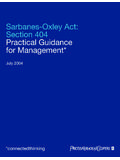Transcription of Introductory note - OECD.org
1 OECD 2011. A publication of the Investment Division of the OECD Directorate for Financial and Enterprise Affairs. OECD freely authorises the use of this material for non-commercial purposes. All requests for commercial use or translation of this material should be submitted to This work is published on the responsibility of the Secretary-General of the OECD. The opinions expressed and arguments employed herein do not necessarily reflect the official views of the Organisation or of the governments of its member countries.
2 This document and any map included herein are without prejudice to the status of or sovereignty over any territory, to the delimitation of international frontiers and boundaries and to the name of any territory, city or area. POLICY FRAMEWORK FOR INVESTMENT USER S TOOLKIT Chapter 1. Investment Policy Introductory note The PFI User s Toolkit responds to a need for specific and practical implementation guidance revealed from the experience of the countries that have already undertaken a PFI assessment.
3 Development of the Toolkit has involved government users, co-operation with other organisations, OECD Committees with specialised expertise in the policy areas covered by the PFI and interested stakeholders. This document offers guidance relating to the PFI chapter on Investment Policy. The PFI User s Toolkit is purposely structured in a way that is amenable to producing a web-based publication. A web-based format allows: a flexible approach to providing updates and additions; PFI users to download the guidance only relevant to the specific PFI application being implemented; and a portal offering users more detailed resources and guidance on each PFI question.
4 The website is accessible at 2 Investment Policy Investment policy in the PFI relates to a country s laws, regulations and practices that directly enable or discourage investment and that enhance the public benefit from investment. It covers, for instance, policies for transparent and non-discriminatory treatment of investors, expropriation and compensation laws and dispute settlement practices. The quality of a country s investment policies directly influences the decisions of investors, be they small or large, domestic or foreign.
5 Transparency, property protection and non-discrimination are core investment policy principles that underpin efforts to create a quality investment environment for all. Investors are also concerned with the way that investment policy is formulated and changed. They will avoid circumstances where policies are modified at short notice, where governments do not consult with industry on proposed changes and where laws, regulations and procedures are not clear, readily available and predictable. The PFI Investment Policy chapter identifies through eight questions the most important issues relevant for judging the effectiveness of a country s investment policies and practices.
6 The issues are often directly relevant to the specific needs of foreign investors, but they apply in most instances to domestic investors as well. This section of the Toolkit offers additional detail on why these investment policy questions are important, and specific guidance on the topics to scrutinise in order to form an opinion on how well a country s investment policies perform vis- -vis good practices. The eight PFI questions on Investment Policy relate to: Laws and regulations Effective ownership registration Intellectual property rights Contract enforcement and dispute resolution Expropriation laws and review processes Non-discriminatory treatment for national and international investors International co-operation and periodic review International arbitration instruments 3 Laws and Regulations What steps has the government taken to ensure that the laws and regulations dealing with investments and investors.
7 Including small- and medium-sized enterprises, and their implementation and enforcement are clear, transparent, readily accessible and do not impose unnecessary burdens? Rationale for the question Policy uncertainty encompasses both predictability and transparency and is one of the greatest obstacles to investment. Firms need to know what the rules of the game are and require some assurance that those rules will not change once they have invested. Their views, along with other stakeholders, should also be solicited when policies are being developed or revised.
8 Going beyond the rules and regulations themselves, their implementation and enforcement should be clear and transparent. Investors need to understand the practical implications of rules governing their investment, in terms of the conditions to fulfil, the procedures for a public review and the appeals process in the event of a dispute. This process can help to institutionalise procedural transparency by systematically ensuring that changes in implementing regulations and administrative decisions are subject to public review and appeals.
9 Rules and procedures should be designed in a way which achieves stated policy goals while imposing the least cost on investors in terms of red tape. Unnecessary administrative burdens can be a significant cost for potential investors, especially for small and medium-sized enterprises (SMEs), and can help to account for both a low level of investment and a high share of SMEs in the informal sector where rules can more easily be circumvented. Key considerations To promote investment, governments can consult with interested parties, simplify and codify legislation, use plain language drafting, develop registers of existing and proposed regulations, disseminate regulatory material electronically, and publish and review administrative decisions.
10 Availability of relevant information to investors Information is the lifeblood of well-functioning markets. Meaningful information on all measures materially affecting a firm s investments should be readily available, and to reassure all market participants that business operates on a level playing field, investment laws and regulations and their enforcement should be codified and clear to all. This requires a consistent, predictable system of laws, policies, regulations and administrative practices, as well as information on rulings and judicial decisions.















